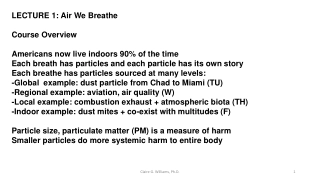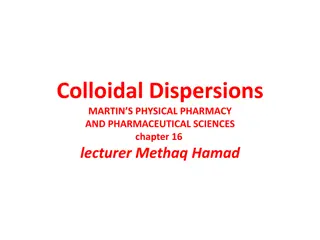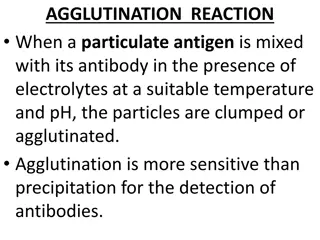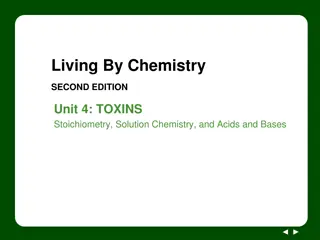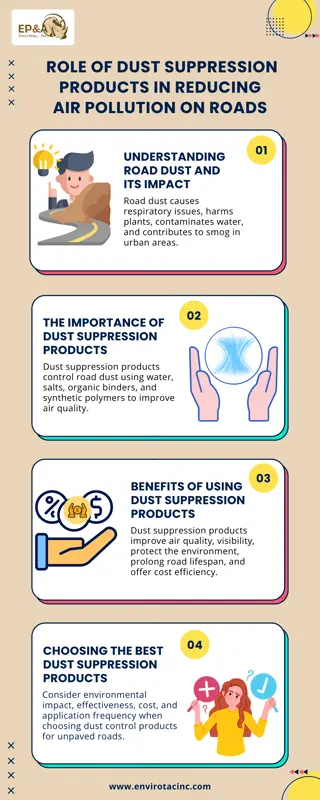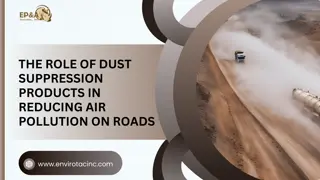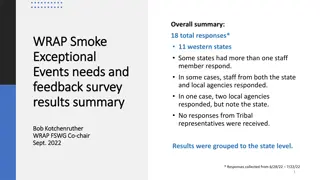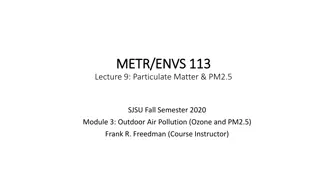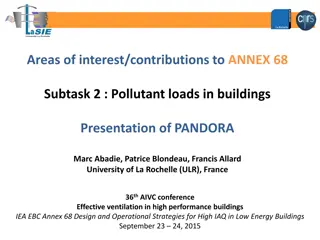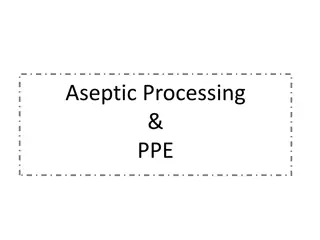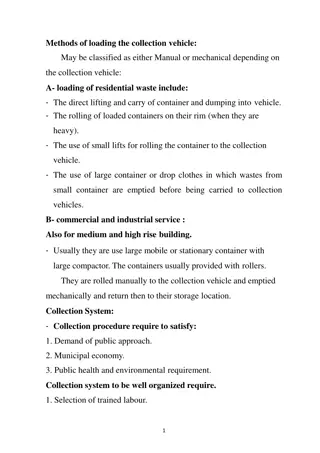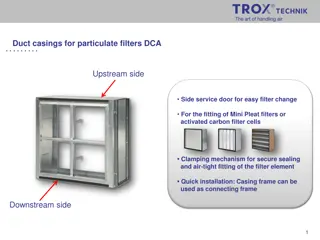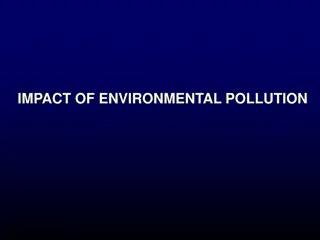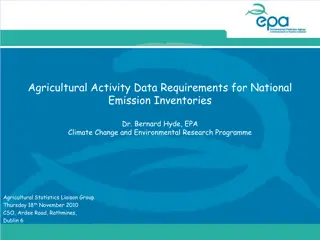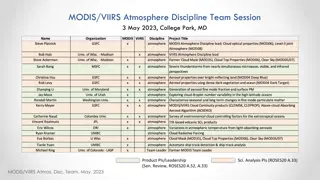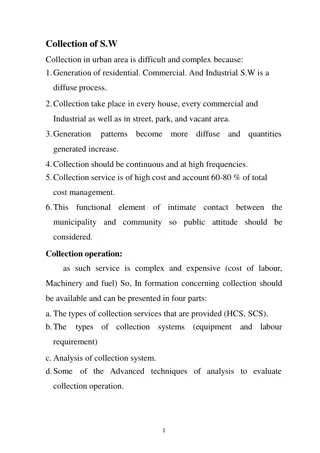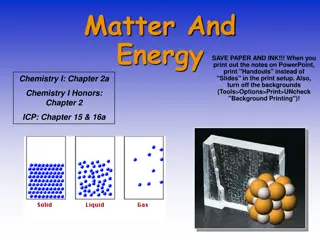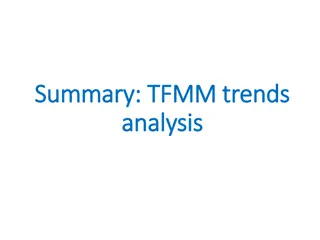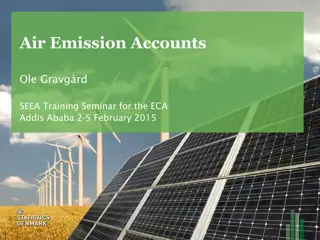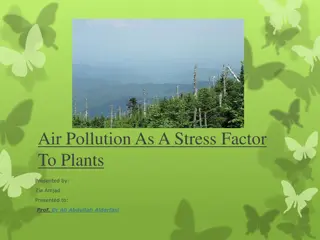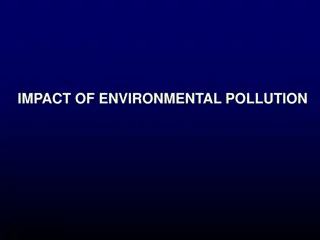LECTURE 1: Air We Breathe Course Overview
Americans predominantly spend 90% of their time indoors, where each breath taken contains particles sourced from various levels - global, regional, local, and indoor sources. These particles, known as particulate matter (PM), can have differing effects on the body based on their size, with smaller p
2 views • 18 slides
Advancements in Hydrogen Combustion for Internal Combustion Engines
Exploring the utilization of hydrogen as a sustainable fuel for internal combustion engines, this research delves into the mixing, combustion, and particulate formation processes in H2ICE. Discussions cover the benefits of hydrogen, challenges faced, and innovative solutions like onboard on-demand h
0 views • 21 slides
Impact of Burning Firewood vs. Compressed Logs on PM2.5 Concentrations
Study comparing the effects of burning firewood and compressed logs on PM2.5 concentrations. Results show that compressed logs produce significantly lower particulate matter pollution. Recommendations include using compressed wood for reduced smoke emission. Various brands and types of compressed lo
0 views • 10 slides
Exploring the Legacy of Gregor Mendel: Pioneer of Genetics
Gregor Mendel, an Austrian monk, revolutionized the understanding of heredity with his formulation of fundamental laws in the 1860s. Contrary to the prevailing blending theory of inheritance, Mendel's particulate theory explained species diversity and variation effectively. By meticulously conductin
2 views • 20 slides
Understanding Colloidal Dispersions in Physical Pharmacy
Colloidal dispersions consist of particulate matter distributed throughout a medium. They can be classified based on particle diameter, with molecular, colloidal, and coarse dispersions being common types. The enormous surface area of colloidal particles leads to unique properties, such as catalytic
1 views • 69 slides
Understanding Agglutination Reactions in Immunology
Agglutination reaction is a key technique in immunology where particulate antigens and antibodies clump together in the presence of electrolytes. This reaction is highly sensitive and often used for antibody detection, bacterial identification, blood grouping, and cross-matching. The process involve
0 views • 20 slides
Understanding Acids and Bases: Definitions and Behavior
Explore the definitions of acids and bases according to Arrhenius and Brønsted-Lowry theories, their behavior at a particulate level, and the differences between strong and weak acids and bases. Learn how to define, identify, and understand the properties of acids and bases through practical exampl
0 views • 12 slides
Air Quality Management Division Overview
The Air Quality Management Division in Reno, Sparks, and Washoe County focuses on implementing clean air solutions through community partnerships and various programs and services such as air monitoring, permitting, compliance, planning, and public education. The division ensures compliance with amb
1 views • 8 slides
Impact of Particulate Pollution on Pear Packers' Productivity
Study explores how exposure to particulate matter (PM2.5) affects worker productivity in a pear packing plant. Findings suggest a negative relationship between PM2.5 levels and productivity, potentially due to health effects such as respiratory and cardiovascular problems. The research uses linear r
0 views • 12 slides
Pharmaceutical Dosage Form Design and Drug Delivery Systems Overview
Understanding pH-solubility profiles of drugs like indomethacin, chlorpromazine, and oxytetracycline is crucial in formulating pharmaceuticals. Factors affecting dissolution rates, such as particle size and solubility, can be optimized to enhance drug absorption. Different methods like particle size
0 views • 46 slides
Overview of Fruit and Vegetable Pulping Equipments in Food Engineering
The process of pulping fruits and vegetables involves crushing them to separate the pulp from seeds and skin using various types of pulping equipment. Different pulpers such as fruit crushers, fruit presses, and stainless steel pulpers are used based on the size, shape, and texture of the produce. T
0 views • 9 slides
The Role of Dust Suppression Products in Reducing Air Pollution on Roads
Dust suppression products reduce airborne particulate matter from roads, improving air quality, visibility, and environmental health while extending road lifespan.\n
0 views • 1 slides
The Role of Dust Suppression Products in Reducing Air Pollution on Roads
Dust suppression products reduce airborne particulate matter from roads, improving air quality, visibility, and environmental health while extending road lifespan.\n
0 views • 10 slides
Wildfire Smoke Exceptional Events Survey Summary
Survey results indicate that staff across various organizations in 11 Western states possess the expertise to develop wildfire smoke exceptional events demonstrations for particulate matter and ozone. The majority of states express readiness to assist other organizations and seek training to enhance
0 views • 17 slides
Best Basket Strainer Manufacturers Worldwide
Basket strainers are essential components used in various industries, including oil and gas, water treatment, and chemical processing. They are designed to remove debris and particulate matter from liquids, protecting valuable equipment from damage a
1 views • 9 slides
Understanding Particulate Matter (PM) and Its Health Effects
Particulate Matter (PM) refers to tiny particles suspended in the air that can have significant health effects, especially PM2.5 which can penetrate deep into the lungs. This overview covers the composition, sources, health effects, particle sizes, lung penetration, regulatory standards, and ambient
0 views • 34 slides
Comprehensive Alignment of MOE Chemistry Syllabus with Khan Academy Resources
This comprehensive alignment showcases the correlation between the Ministry of Education (MOE) chemistry syllabus and the educational resources provided by Khan Academy. It covers various topics in chemistry such as the particulate nature of matter, atomic structure, chemical bonding, stoichiometry,
1 views • 9 slides
Understanding Data Collection and Analysis for Businesses
Explore the impact and role of data utilization in organizations through the investigation of data collection methods, data quality, decision-making processes, reliability of collection methods, factors affecting data quality, and privacy considerations. Two scenarios are presented: data collection
1 views • 24 slides
PANDORA: Indoor Air Pollutant Emissions Database Presentation
Delve into the comprehensive PANDORA database, developed by LaSIE at the University of La Rochelle, focusing on emission rates of gaseous and particulate pollutants from various sources in buildings. Explore emission models, basic and overall structures, and the main interface for understanding and
3 views • 10 slides
Understanding Diesel Engine Emissions Control Systems in Transit Buses
This educational material focuses on the operations and components of diesel engine emissions control systems, specifically DOC with DPF systems in transit buses. Learn about the role of exhaust after-treatment, dosing valve injector, diesel oxidation catalyst, and diesel particulate filter. Explore
0 views • 45 slides
Understanding Aseptic Processing and Contamination Control in Cleanroom Environments
Aseptic processing involves maintaining a sterile environment to prevent contamination in cleanroom settings. The presence of non-viable and viable particulate contamination, such as dust and live microorganisms, poses challenges. Sources of contamination include equipment, structures, surfaces, and
0 views • 29 slides
Waste Collection Systems Overview and Best Practices
Waste collection systems can be classified as manual or mechanical based on the type of collection vehicle used. Residential waste loading methods include direct lifting, rolling of containers, and use of lifts. Commercial and industrial services typically utilize large mobile or stationary containe
0 views • 7 slides
Insights on Biogeochemical Processes and Metal Interactions in Marine Environments
Delve into the intricate relationships between metals, stoichiometry, and biological quotas in marine ecosystems. Explore the impact of metal interactions on biogeochemical provinces, resource supply stoichiometry, and the constraints they impose on marine biota. Uncover how deep chlorophyll maxima,
0 views • 5 slides
Introduction to Environmental Thermal Engineering: Air Conditioning Systems and HVAC Applications
This lecture covers the fundamentals of air conditioning systems, including the equipment, HVAC systems, and applications. It explains the concept of air conditioning, its processes, and its significance in controlling temperature, humidity, cleanliness, and air distribution for occupant comfort. Ad
0 views • 85 slides
Overview of Clean Air Act: Criteria Pollutants, NAAQS, HAPs, VOCs
The Clean Air Act establishes standards for criteria pollutants like ozone and particulate matter to protect human health. NAAQS set uniform air quality goals, while Hazardous Air Pollutants (HAPs) pose threats such as cancer. Volatile Organic Compounds (VOCs) and National Emission Standards for HAP
0 views • 26 slides
Duct Casings for Particulate Filters DCA: Installation and Filter Element Fitting
Explore the features and installation process of Duct Casings for Particulate Filters DCA, with a focus on easy filter changes, Mini Pleat filter fitting, clamping mechanisms for secure sealing, and support brackets for filter elements. Ensure proper airflow, sealing, and airtight fitting for optima
0 views • 4 slides
Understanding Data Collection Methods for Business Analysis
Data collection is essential for analyzing business performance and making informed decisions. Various data collection methods like primary and secondary data collection help evaluate outcomes and draw conclusions. Primary data includes raw information obtained firsthand, while quantitative methods
0 views • 15 slides
Understanding the Impact of Environmental Pollution on Human Health
Environmental pollution, including air, water, soil, and waste pollution, poses serious threats to ecosystems and human health. Air pollutants like particulate matter can lead to respiratory issues, while smog, a combination of smoke and fog, creates urban air quality problems. Different types of sm
0 views • 61 slides
Overview of WEEE Collection in Baltic States
This presentation explores the WEEE (Waste Electrical and Electronic Equipment) collection practices in Estonia, Latvia, and Lithuania. It covers the targets set by the WEEE directive 2012/19/EU, the setup of collection systems, and the results achieved. The content delves into the minimum collectio
0 views • 19 slides
Agricultural Emission Inventory Data Reporting Requirements
This presentation discusses the data requirements for national emission inventories in the agricultural sector, covering greenhouse gas inventories, air pollutant inventories, National Inventory Reports, Large Combustion Plant Directive, National Emission Ceilings Directive, livestock emissions, and
0 views • 13 slides
Mapping Soil Organic Carbon Fractions in Australia: Stocks and Uncertainty
This study by Mercedes Román Dobarco et al. focuses on mapping soil organic carbon fractions across Australia, including mineral-associated organic carbon, particulate organic carbon, and pyrogenic organic carbon. The research involves prediction of soil organic carbon fractions using spectral libr
0 views • 17 slides
MODIS/VIIRS Atmosphere Discipline Team Session - May 2023, College Park, MD
The MODIS/VIIRS Atmosphere Discipline Team hosted a session in May 2023 at College Park, MD, focusing on various aspects of atmospheric science. The session included presentations on aerosols, clouds, data access, continuity products, and new science products. Speakers discussed topics such as ambie
0 views • 4 slides
Challenges and Strategies in Solid Waste Collection in Urban Areas
Solid waste collection in urban areas is complex due to the diffuse nature of waste generation, varied collection locations, increased quantities of waste, high costs, and the need for continuous service. Different collection methods and systems such as curbside pick-up, alley service, set-out set-b
0 views • 5 slides
Understanding Matter and Energy in Chemistry: A Comprehensive Overview
Exploring the intricate nature of matter, this collection delves into the fundamentals of chemistry, from the macroscopic to the particulate level. Covering topics such as the states of matter, kinetic nature, physical properties, and other states of matter like plasma and Bose-Einstein condensate,
0 views • 18 slides
Trends Analysis in Air Pollution Monitoring and Assessment
Trends analysis in air pollution monitoring and assessment involves studying variables recommended for measurements at different EMEP stations, focusing on photo-oxidants, particulate matter, heavy metals, and more. The period and time granularity, data filtering methods, and the importance of data
0 views • 8 slides
Understanding Air Emission Accounts and Bridge Tables
Flows of air emissions, including gaseous and particulate substances released into the atmosphere, are recorded in Air Emission Accounts following specific guidelines and considerations. Bridge tables play a crucial role in reconciling differences between national economy totals and emission invento
0 views • 18 slides
Understanding Air Pollution Stress on Plants
The impact of air pollution on plants is a significant concern, affecting their physiology and overall health. Various air pollutants, such as sulfur dioxide, ozone, and nitrogen compounds, have been identified as phytotoxic agents, leading to severe or subtle effects on plant life. Detecting the ef
0 views • 21 slides
Understanding Air Pollution and Its Impact
Air pollution, characterized by the release of harmful chemicals, particulate matter, and biological materials into the atmosphere, poses a severe threat to both living organisms and the environment. Smog, a common consequence of burning coal and heavy oil containing sulphur, engulfs regions like Ho
0 views • 11 slides
Understanding the Impact of Environmental Pollution
Environmental pollution, caused by the introduction of contaminants into the air, water, and soil, has detrimental effects on ecosystems and human health. This pollution includes air pollution from various sources like combustion and industrial processes, leading to the formation of harmful pollutan
0 views • 61 slides
Comprehensive Guide to Blood Collection Techniques in Medical Investigations
Blood collection is a crucial process in medical investigations where blood is withdrawn from patients for analysis. Methods include arterial sampling, venipuncture, and fingerstick sampling, each serving specific purposes. Venous blood is preferred over arterial blood due to accessibility and ease
0 views • 10 slides
